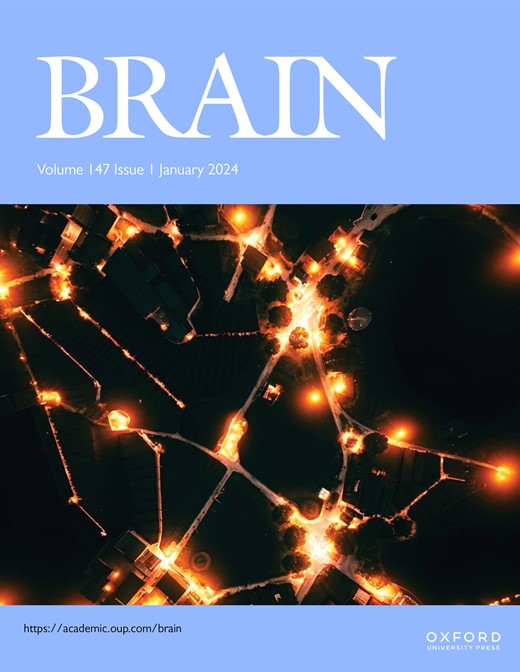右额叶网络用于类比和演绎推理的右额叶网络
IF 10.6
1区 医学
Q1 CLINICAL NEUROLOGY
引用次数: 0
摘要
两种被研究得最多的推理类型是类比推理(AR)和演绎推理(DR)。然而,我们对推理能力与其神经解剖学基础之间关系的理解仍然非常有限。我们的目的是在大量单侧局灶性额部或后部病变患者和健康对照者中,对AR、DR和流体智力(Gf)测试的表现进行精细的解剖定位。我们使用两种新的测试评估了247名前瞻性招募的患者:类比推理测试(ART)和演绎推理测试(DRT);以及最成熟的Gf测量方法:雷文先进渐进矩阵(RAPM)。采用非参数贝叶斯随机块模型揭示病变缺陷网络的群落结构,将功能与混杂的病理分布效应分离开来。额叶病变患者ART和DRT表现明显受损[ART: F(2238) = 18.93;P, lt;0.001;额叶组比后叶组和健康对照组更差,P <;0.001;dr: f (2,387) = 18.491;P, lt;0.001;额叶组较健康对照组差P &;lt;0.01]。右额叶效应在两个测试中都很明显。因此,在ART上,右额叶患者比左额叶受损更严重(P <;0.05)。在DRT上,右额叶患者比左额叶患者在不确定答案的问题上受损更严重(P <;0.05),但在具有确定问题的问题上没有。非参数贝叶斯随机块模型暗示了ART和DRT性能中的右额叶网络。引人注目的是,我们发现这个网络也与RAPM的表现有关。我们的研究是对局灶性脑损伤的AR和DR最有力的研究。我们的研究结果表明,右额叶网络是至关重要的。ART和DRT似乎是有希望的新的临床试验,能够评估推理能力和识别右额叶功能障碍。本文章由计算机程序翻译,如有差异,请以英文原文为准。
A right frontal network for analogical and deductive reasoning
Two of the most well-studied types of reasoning are analogical reasoning (AR) and deductive reasoning (DR). Yet, our understanding of the relationship between reasoning abilities and their neuroanatomical basis remains surprisingly limited. We aimed to conduct fine-grained anatomical mapping of performance on tests of AR, DR and fluid intelligence (Gf), in a large sample of patients with unilateral focal frontal or posterior lesions and healthy controls. We assessed 247 prospectively recruited patients using two new tests: the Analogical Reasoning Test (ART) and the Deductive Reasoning Test (DRT); and the best-established measure of Gf: Raven’s Advanced Progressive Matrices (RAPM). Non-parametric Bayesian stochastic block modelling was used to reveal the community structure of lesion deficit networks, disentangling functional from confounding pathological distributed effects. ART and DRT performance was significantly impaired in patients with frontal lesions [ART: F(2,238) = 18.93; P < 0.001; Frontal group worse than Posterior group and healthy controls, both P < 0.001; DRT: F(2,387) = 18.491; P < 0.001; Frontal group worse than healthy controls, P < 0.01]. Right frontal effects were evident on both tests. Thus, on the ART, right frontal patients were more impaired than left (P < 0.05). On the DRT, right frontal patients were more impaired than left frontal patients on questions with indeterminate solutions (P < 0.05) but not on questions with determinate ones. Non-parametric Bayesian stochastic block modelling implicated a right frontal network in ART and DRT performance. Strikingly, we found that this network was also implicated in performance on RAPM. Our study represents the most robust investigation of AR and DR in the focally injured brain. Our findings imply that a right frontal network is critical. The ART and DRT appear to be promising new clinical tests, capable of evaluating reasoning abilities and identifying right frontal lobe dysfunction.
求助全文
通过发布文献求助,成功后即可免费获取论文全文。
去求助
来源期刊

Brain
医学-临床神经学
CiteScore
20.30
自引率
4.10%
发文量
458
审稿时长
3-6 weeks
期刊介绍:
Brain, a journal focused on clinical neurology and translational neuroscience, has been publishing landmark papers since 1878. The journal aims to expand its scope by including studies that shed light on disease mechanisms and conducting innovative clinical trials for brain disorders. With a wide range of topics covered, the Editorial Board represents the international readership and diverse coverage of the journal. Accepted articles are promptly posted online, typically within a few weeks of acceptance. As of 2022, Brain holds an impressive impact factor of 14.5, according to the Journal Citation Reports.
 求助内容:
求助内容: 应助结果提醒方式:
应助结果提醒方式:


